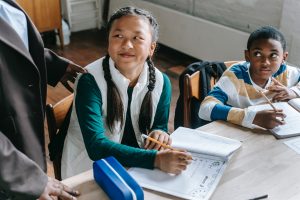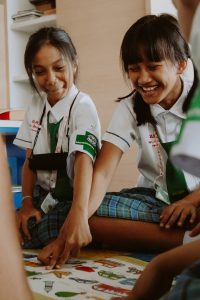5 Intervention for Language Disorder in Children from Multilingual Backgrounds
At times, parents and teachers erroneously believe that providing an English-only environment will be the best way to support dual language learners (DLLs). However, it is best practice to support children’s language development in English and their home language(s). Home languages should be incorporated into the school and intervention when possible. Tominey and O’Bryon (2017) suggest the following opportunities to include children’s home languages into the classroom environment:
- Children in the class can demonstrate counting in their home languages during calendar time
- Teach and provide opportunities for the class to practice phrases that encourage prosocial behaviors, such as, greetings or requests or invitations to join groups in the languages spoken by class members
- During partner activities, alternate between pairing children with classmates who speak different languages and pairing children who speak the same language. Children who speak the same language can help each other preserve the home language, and children who speak different languages can learn about each other’s languages.
- Label items in the classroom in each of the languages spoken by members of the class. In a school taught in English, the English label will help with the English reading and writing of the words. Providing the labels in other languages will support the home languages of the multilingual students and will benefit all students by exposing them to multiple languages.
Tominey and O’Bryon (2017) also suggest some best practices for the beginning of the year. Ensuring that children can independently access materials or easily indicate what they need is important as they are developing their classroom vocabulary. This strategy can free up the teacher to provide the help to the children who truly need it. Teachers should keep group lessons fairly short at the beginning of the year, and increase the lesson length gradually. Providing more small-group than large-group activities can provide teachers with more opportunities to get to know each student and provide individualized support.
Intervention in both languages is optimal for bilingual students. Providing treatment in L2 only results in minimal gains in L1, whereas providing treatment in L1 results in gains in L1 and L2 (Ebert et al., 2014). When this is not feasible, the SLP should endeavor to connect elements of the child’s primary language to the intervention. For example, the SLP can learn vocabulary words from the child’s primary language and use these in intervention. School personnel who speak the child’s L1 can be involved in the intervention sessions or can provide assistance with planning sessions to help improve vocabulary in L1 if the SLP does not speak the child’s L1 (Kohnert et al., 2021). SLPs also can invite peers who speak the child’s L1 to the session (Kohnert et al., 2005; Ebert et al., 2014). As with all peer intervention, it is important to ensure that the student receiving intervention has opportunities to be a “leader” during the session, rather than creating a hierarchical relationship between the students. A parent-coaching model also can be effective treatment method for bilingual children (Kohnert et al., 2005). In this model, parents are trained by the SLP to be the primary provider of the intervention. Even if a parent-coaching model is not used and the SLP is the primary provider of direct intervention, activities should be given to the family that can be conducted in the course of everyday life, and involve communication in the primary language or both the primary language and English, such as discussing pictures or stories used during intervention sessions (Pieretti & Roseberry-McKibbin, 2016).
Like intervention with monolingual English speakers, language intervention with bilingual speakers should be connected to educational standards (Pieretti & Roseberry-McKibbin, 2016; Roseberry-McKibbin, 2021). Kohnert and colleagues (2005) describe the bilingual approach and the cross-linguistic approach to treatment of language disorders in bilingual children. The bilingual approach focuses on the treatment of constructs common to both languages. This approach results in improvement in communication in both languages. One example of a bilingual approach is targeting cognates (Dam et al., 2020). A focus on content-area cognates is particularly beneficial to bilingual children. For example, in geometry, an English-Spanish cognate is sphere (esfera), and in geography an English-Spanish cognate is volcanic (volcanico) (Roseberry-McKibbin, 2021). As with monolingual children with DLD, bilingual children with DLD should be given multiple exposures to vocabulary words and should have opportunities to actively engage with the words in a variety of contexts. Tier 2 words, or words that are commonly used in multiple contexts but often require explicit teaching, are ideal targets (Dam et al., 2020; Roseberry-McKibbin, 2021).

Dam et al. (2020) provided a six-week Tier 2 vocabulary intervention to bilingual Spanish-English speakers, which resulted in improved word-definition quality and cognate naming. This intervention consisted of mediated learning experiences, which were characterized by intentionality, or a statement of the goal of the session; meaning, an explanation of the goal; transcendence, making connections between new skills and their use in other contexts; and competence, which promoted self-monitoring. Eight Tier 2 words were targeted from each of four storybooks. Sessions began with a statement and explanation of the goal. The target words and their parts of speech were reviewed. Children matched definition cards to target words from a choice of four. The clinician read the story, emphasizing the target words. The children raised their hands when they heard the target words in the story, and for the first occurrence of the word, the clinician repeated the word, defined it, and repeated the sentence containing the word. In later sessions, the children, rather than the clinician, provided the definition when the word occurred in the story for the first time. During the first session, the concept of cognates was taught. During subsequent sessions, the clinician wrote the cognate words in Spanish and English on a whiteboard and children circled letters that appeared in both words to identify similarities in spelling. The children then played a board game with cards of cognate and non-cognate words in which they stated whether or not the word pair consisted of cognates. Next, children matched words to their definitions. After matching, they created sentences using the words or filled in the blank in a sentence when given a choice of two words. At the end of the session, the clinician summarized the goal and what was accomplished in the session, connected new skills to other contexts, and discussed the plan for the next session.
Similarly, Wood et al. (2018) targeted vocabulary via e-books. The e-books displayed the words while a recording provided the story auditorally. Each session began with a preview of the target words in English and Spanish, which included pictures with audio labels in English and Spanish. For the first occurrence of the word, audio of an explanation of the word in English and Spanish played. The second time the target word occurred, a video clip depicting the function of the word played. As a check, the child constructed a word map by first selecting a picture representing the target word, then selecting a picture that did NOT show the target word, then adding a prefix or suffix to highlight the morphology.
Phonological awareness skills, which are necessary for written language development (National Reading Panel (US), 2000), also support the development of vocabulary knowledge. Phonological awareness is discussed further in the section on written language in this book. Roseberry-McKibbon (2021) suggests the following phonological awareness activities for bilingual children. First, children can count the number of words in a sentence, syllables in a word, and sounds in a word. They can work on isolating and producing the onset (consonants prior to the nucleus, or vowel), rime (the nucleus and coda, or consonant sounds after the vowel), and coda of a single-syllable word. They can segment onsets and rimes and then individual sounds to form words. Roseberry-McKibbon (2021) provides the following hierarchy for teaching bilingual children with DLD Tier 2 vocabulary words. This hierarchy incorporates phonological awareness activities.
- Point to pictures representing the target words
- Answer yes/no to whether a picture represents a target word
- Select the correct target word to match a verbally-presented definition , given a choice of two
- Provide a one-word label for a picture
- Provide a description of a target word using at least five word
- Use the target word in a sentence
- Find the target word in a written paragraph or word list
- Spell the target word aloud
- Write a sentence containing the target word
- Count the number or words in the sentence containing the target word
- Count the number of syllables in the target word
- Count the number of sounds in the target word
- Provide a word that rhymes with the target word
- Blend the sounds in the target word when the clinician produces them phoneme-by-phoneme
- State the first sound in the target word
- State the last sound in the target word

Summary of Intervention for Bilingual Children
In summary, intervention for bilingual children follows the same clinical process as treatment for monolingual children. Providing intervention to bilingual children requires attention to additional considerations, including culture, language dominance, similarities between languages, and involvement of parents, peers, and other community members who speak the child’s L1. Facilitating growth in the school language benefits the child by resulting in academic success and future career readiness. It may also facilitate peer relationships, depending on the linguistic backgrounds of the other children in the school. Yet home language must also be valued so that children can communicate with family and others in their lives who speak their L1. Additionally, supporting the home language can ultimately lead to more career opportunities as bilingual employees are increasingly valued and needed.
References
Dam Q., Pham G. T., Pruitt-Lord S., Limon-Hernandez J., Goodwiler C. (2020). Capitalizing
on cross-language similarities in intervention with bilingual children. Journal of Communication Disorders, 87, 106004. https://doi.org/10.1016/j.jcomdis.2020.106004
Ebert, K.D., Kohnert, K., Pham, G.T., Disher, J.R., & Payesteh, B. (2014). Three treatments for bilingual children with primary language impairment: examining cross-linguistic and cross-domain effects. Journal of Speech, Language, and Hearing Research, 57, 172-186.https://doi.org/10.1044/1092-4388(2013/12-0388)
Kohnert K., Ebert K.D., Pham G.T. (2021). Language disorders in bilingual children and adults (3rd ed.). Plural Publishing.
Kohnert, K., Yim, D., Nett, K., Kan, P.F., & Duran, L. (2005). Intervention with linguistically diverse preschool children: A focus on developing home language(s). Language, Speech, Hearing Services in Schools, 36, 251-263. https://doi.org/10.1044/0161-1461(2005/025)
National Reading Panel (US), National Institute of Child Health, & Human Development (US). (2000). Report of the National Reading Panel: Teaching children to read: An evidence-based assessment of the scientific research literature on reading and its implications for reading instruction(Vol. 1). National Institute of Child Health and Human Development, National Institutes of Health.
Pieretti, R. A., & Roseberry-McKibbin, C. (2016). Assessment and intervention for English language learners with primary language impairment: Research-based best practices. Communication Disorders Quarterly, 37(2), 117-128.
Roseberry-McKibbin, C. (2021). Intervention for English learners with developmental language disorder: Connecting to classroom English language arts curriculum through increasing academic vocabulary skills. Topics in Language Disorders, 41, 322-332.
Tominey, S., O’Bryon, E. C., & Díaz, G. (2018). 45 strategies that support young dual language learners. Paul H. Brookes Publishing Company.
Wood, C., Fitton, L., Petscher, Y., Rodriguez, E., Sunderman, G., & Lim, T. (2018). The effect of e-book vocabulary instruction on Spanish–English speaking children. Journal of Speech, Language, and Hearing Research, 61(8), 1945-1969.
knowledge of the sound structure of words
